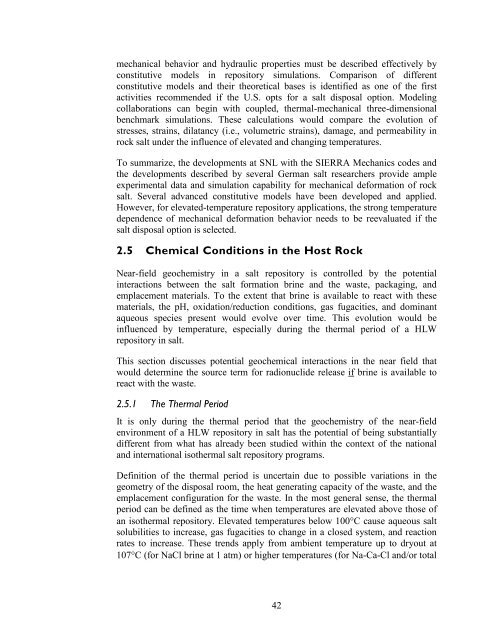Salt Disposal of Heat-Generating Nuclear Waste
Salt Disposal of Heat-Generating Nuclear Waste
Salt Disposal of Heat-Generating Nuclear Waste
Create successful ePaper yourself
Turn your PDF publications into a flip-book with our unique Google optimized e-Paper software.
mechanical behavior and hydraulic properties must be described effectively by<br />
constitutive models in repository simulations. Comparison <strong>of</strong> different<br />
constitutive models and their theoretical bases is identified as one <strong>of</strong> the first<br />
activities recommended if the U.S. opts for a salt disposal option. Modeling<br />
collaborations can begin with coupled, thermal-mechanical three-dimensional<br />
benchmark simulations. These calculations would compare the evolution <strong>of</strong><br />
stresses, strains, dilatancy (i.e., volumetric strains), damage, and permeability in<br />
rock salt under the influence <strong>of</strong> elevated and changing temperatures.<br />
To summarize, the developments at SNL with the SIERRA Mechanics codes and<br />
the developments described by several German salt researchers provide ample<br />
experimental data and simulation capability for mechanical deformation <strong>of</strong> rock<br />
salt. Several advanced constitutive models have been developed and applied.<br />
However, for elevated-temperature repository applications, the strong temperature<br />
dependence <strong>of</strong> mechanical deformation behavior needs to be reevaluated if the<br />
salt disposal option is selected.<br />
2.5 Chemical Conditions in the Host Rock<br />
Near-field geochemistry in a salt repository is controlled by the potential<br />
interactions between the salt formation brine and the waste, packaging, and<br />
emplacement materials. To the extent that brine is available to react with these<br />
materials, the pH, oxidation/reduction conditions, gas fugacities, and dominant<br />
aqueous species present would evolve over time. This evolution would be<br />
influenced by temperature, especially during the thermal period <strong>of</strong> a HLW<br />
repository in salt.<br />
This section discusses potential geochemical interactions in the near field that<br />
would determine the source term for radionuclide release if brine is available to<br />
react with the waste.<br />
2.5.1 The Thermal Period<br />
It is only during the thermal period that the geochemistry <strong>of</strong> the near-field<br />
environment <strong>of</strong> a HLW repository in salt has the potential <strong>of</strong> being substantially<br />
different from what has already been studied within the context <strong>of</strong> the national<br />
and international isothermal salt repository programs.<br />
Definition <strong>of</strong> the thermal period is uncertain due to possible variations in the<br />
geometry <strong>of</strong> the disposal room, the heat generating capacity <strong>of</strong> the waste, and the<br />
emplacement configuration for the waste. In the most general sense, the thermal<br />
period can be defined as the time when temperatures are elevated above those <strong>of</strong><br />
an isothermal repository. Elevated temperatures below 100°C cause aqueous salt<br />
solubilities to increase, gas fugacities to change in a closed system, and reaction<br />
rates to increase. These trends apply from ambient temperature up to dryout at<br />
107°C (for NaCl brine at 1 atm) or higher temperatures (for Na-Ca-Cl and/or total<br />
42
















